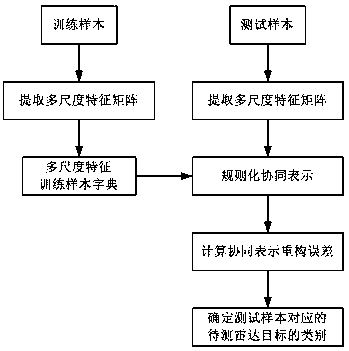SAR Target Recognition Method Based on Cooperative Representation of Multi-scale Features
A multi-scale feature and collaborative representation technology, which is applied in scene recognition, character and pattern recognition, instruments, etc., can solve the problems of complicated target recognition processing process and low recognition processing efficiency, and solve the problem that the target recognition processing process is relatively complicated and efficient. Accuracy of target recognition and high efficiency of recognition processing
- Summary
- Abstract
- Description
- Claims
- Application Information
AI Technical Summary
Problems solved by technology
Method used
Image
Examples
Embodiment
[0094] This embodiment uses the MSTAR database to do the experiment, which is the measured data obtained by the X-band SAR system of the San Diego National Laboratory in the United States. It has a resolution of 0.3m × 0.3m, and is respectively at the pitch angle of 15 degrees and 17 degrees. acquired. In this embodiment, three types of targets, BMP2 (infantry tank), BTR70 (armored personnel carrier), and T72 (T-72 main station tank) in the MSTAR database are used for experiments. The visible light images of BMP2, BTR70, and T72 three different types of radar targets are as follows: figure 2 (2a), (2b), (2c), and the SAR images of three different types of radar targets BMP2, BTR70, and T72 are as follows image 3 In (3a), (3b), (3c) shown. It can be seen that these military or civilian vehicle targets are similar in size and easily confused when identifying them. The pixel density of each SAR image in the MSTAR database is 128 rows × 128 columns. In this embodiment, the SA...
PUM
 Login to View More
Login to View More Abstract
Description
Claims
Application Information
 Login to View More
Login to View More - R&D
- Intellectual Property
- Life Sciences
- Materials
- Tech Scout
- Unparalleled Data Quality
- Higher Quality Content
- 60% Fewer Hallucinations
Browse by: Latest US Patents, China's latest patents, Technical Efficacy Thesaurus, Application Domain, Technology Topic, Popular Technical Reports.
© 2025 PatSnap. All rights reserved.Legal|Privacy policy|Modern Slavery Act Transparency Statement|Sitemap|About US| Contact US: help@patsnap.com



